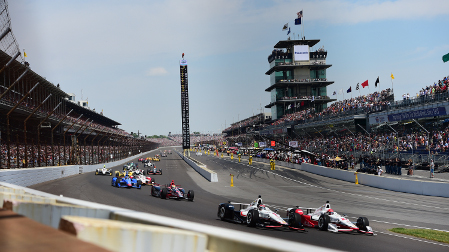Indy 500 Aims to Speed into Living Rooms
INDIANAPOLIS—Drivers will be asked for the 100th time to start their engines this Memorial Day weekend for one of auto racing’s premier events, the Indianapolis 500. First televised in 1949, the live broadcast of the Indy 500 was not an annual event until 1986 by ABC, which has been broadcast the race since the 1960s. Over that time it has strived to bring the intensity and experience of the 500 to fans.
Rich Feinberg had his first experience working the Indy 500 back in 1986 as a production runner. He also worked for ESPN for 23 years, with the Indy 500 being one of his big annual productions, as the sports network handles the production for ABC. He recently took the position of vice president and executive producer with Indianapolis Motor Speedway Productions. He has seen the growth of the production first hand.

“Technology evolution was synonymous with the evolution of the production of the race,” said Feinberg. “As technology has evolved since the ‘80s, so has the ability for media partners to cover racing and put the viewer not only at the event but quite often in the driver’s seat and in the cockpit, and that makes a difference in their viewing experience.”
COVERING ALL ANGLES
Those evolutions have manifested themselves in high-definition cameras; more dynamic camera angles, including in-car cameras; 3D graphics; high-motion cameras; and driver audio playback. This year’s production will continue to expand the scope of ABC/ESPN’s coverage, adding more cameras than ever and offering a live-stream of the full broadcast for the first time.
In a nice bit of symmetry, the production will utilize 100 cameras for the 100th edition of the Indy 500. The cameras, which range from in-car compact cameras to a remote camera on a military base, will offer a variety of viewpoints for fans watching at home. The 100 cameras are the most the production has ever used, but as Kate Jackson, ESPN’s coordinating producer, puts it: “It’s really about trying to find ways to cover more of such a large space and how to enhance the storytelling at home.”
That will include a full live-stream of the race through the WatchESPN app. Over the last three years, viewers have had access to a second-screen experience with WatchESPN with footage from the in-car cameras, giving them the ability to track their favorite driver, the leader, or one weaving through the pack. “It’s a really nice supplement to have,” said Jackson.
Get the TV Tech Newsletter
The professional video industry's #1 source for news, trends and product and tech information. Sign up below.
TECH CHALLENGES
One of the few limitations that the production has is that only 12 of the 33 cars have in-car cameras that can be accessed. A number of factors go into which cars do have them, including sales and sponsorships, but the main reason for the limited number is the amount of RF bandwidth available. “The Indianapolis market is actually limited in the amount of spectrum we can use and get temporary frequencies for,” explained Dennis Cleary, operations producer for the race. But if you’re worried about possible advantages for the other 21 cars not using in-car cameras, the Indy Car league requires that dummy weights/dummy cameras are installed to equal out any weight or aerodynamic issues that may occur.
Clearly also revealed that 4K may be coming to the Indy 500 soon, just not this year. The ABC/ESPN production is still based in 720p and the production requires cameras that can effectively capture at a frame rate of 600 fps. “With the high rate of speed that these cars are travelling, we wanted to make sure that we capture it without any issues,” Clearly said on why they decided to forgo attempting a 4K broadcast. “Maybe next year, maybe the year after as the technology progresses and the cameras progress, but for this year, we definitely had a long conversation about it but we chose not to go that route.”
All of these production elements are meant to serve the viewing audience at home by bringing them as close to the action as possible. That is one element of the production that has not changed over the years. “It was always taken not only with great pride but with individual responsibility to ensure that the broadcast was leading motor sports coverage in terms of storytelling, in terms of event documentation and in terms of use of new and advance technology to show this spectacular event,” Feinberg said.
The 100th Indianapolis 500 will air Sunday, May 29 at 12:00 p.m. on ABC.
